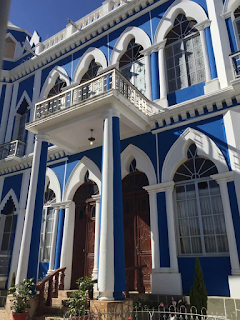Coffee With Anna
If you know me, you know I have
made friends from all over the world.
Somehow they see my posts, probably because of hashtags. I have friends I have never met in Ecuador,
Colombia, India, and Nepal, beside the friend I made in Romania. He encouraged me to visit Romania, and it
became one of my favorite vacations of all times. Just this week someone added me from South Africa wanting to know more about Bolivia. I hope to meet theses friends I have made
face to face one day. Anna was one of
those friends.
Anna is a missionary in Bolivia
who encountered my blog one day shortly after I arrived in July of 2016. Suddenly, there was a woman I had never met
who not only liked my blogs, but commented with details that made my blog come
alive. Often these were memories of the
place from years ago. As we became
friends on Facebook, she gave me suggestions of places to visit and ideas to
research. But we had never met!
Anna has been sick and needed to
visit a doctor near where I live. The
doctor’s visit took longer than she thought it would, so she decided to stay
the night at the New Tribes Mission House, around the corner from where I live. I was out late with my Bolivian family. We ate dinner around 11:00. I usually have my alarm set, but turned it
off this morning. At 7:30, my phone was
screaming at me that I had a message. I
almost ignored it, but now am glad I didn’t.
“I’m at Starbucks for the next
half hour if you want to meet.”
It was from Anna. I almost ran the whole way. That is how excited I was to meet my dear
friend.
Anna is one of those special
people that I am honored to know. She is
about my age, maybe a year or two older.
She has been in Bolivia since she was 8 when her parents came here to be
missionaries. She went to Tambo, a
boarding school between Cochabamba and Santa Cruz. After college she returned to Bolivia, and
has been here ever since. My total time
here is only about 6 years, but because I was here in the 80s, we know a lot of
the same people. In all of our
conversations, I am surprised we haven’t met in the past.
While we were talking, two young
ladies, who are Jehovah’s Witnesses, joined us at our table. I met one of them, Alba, a year ago when I
came to Bolivia for a week to decide if I wanted to return to Bolivia or
not. Since then we bump into each other
all the time. The other lady is named
Sarah. She is married to a Jehovah’s
Witness missionary. Sarah is one of
those people skilled in getting people to talk.
She did that with Anna.
I learned many new things about
Anna as our coffee waxed cold. When she
was a girl, her father was asked by the Bolivian government to broker a peace
agreement between the Yuqui Indians and settlers encroaching on their traditional
homelands. Many had been killed on both
sides. Imagine a time when a president
asks missionaries to do what the government can’t! Anna told stories about translating the bible
into every language in Bolivia. The
translation continues as young Bolivians improve on the translations and make
them more accessible to different dialects.
Think of a Bible translation in Texan or Australian, rather than British
English of 1600. That is what some are doing now.
Here I am writing and travelling,
enjoying being retired, sitting next to a person responsible for the gospel
message reaching so many people in this land I love so much. I am humbled.
Even today she is teaching young men and women from Bolivia, and other
places, to be missionaries to their own people.
This is what it should be like.
As I am writing this a week
later, while visiting Cochabamba, a city she loves as much as I love Santa
Cruz, I think of the places she told me to visit and the stories she told of
when she was a girl here. It makes the
place come alive for me. I know Anna and
I will be friends for many more years to come.
By the way, I stole these pictures from Anna's Facebook page. I don't know if she will come after me or if she will like them. But this is what a missionary looks like.
By the way, I stole these pictures from Anna's Facebook page. I don't know if she will come after me or if she will like them. But this is what a missionary looks like.














































